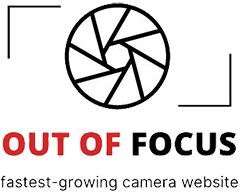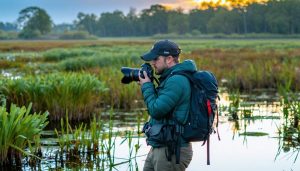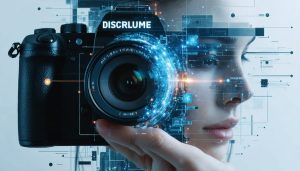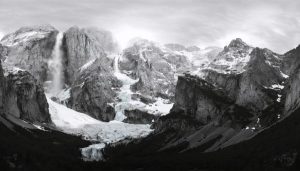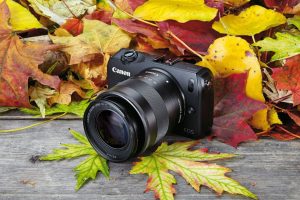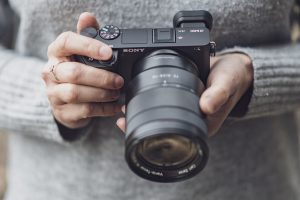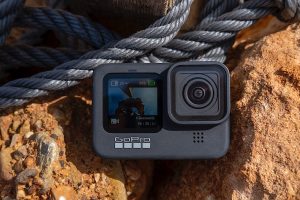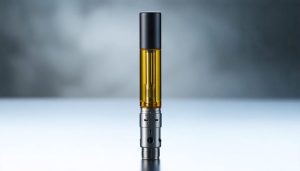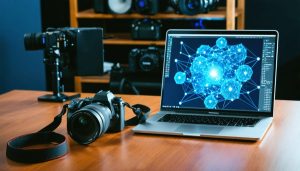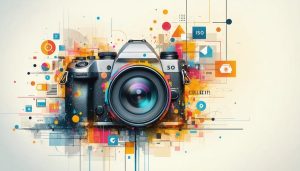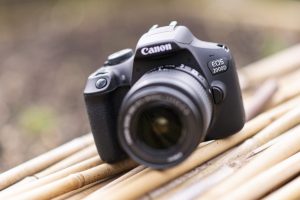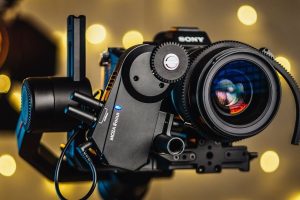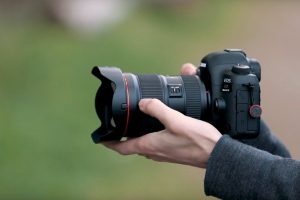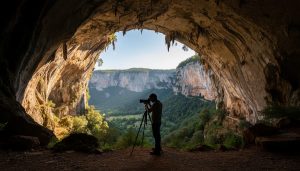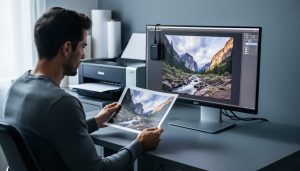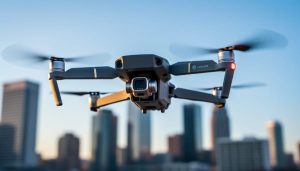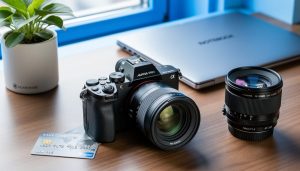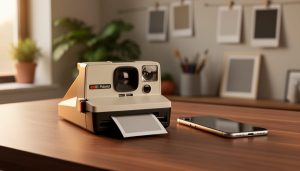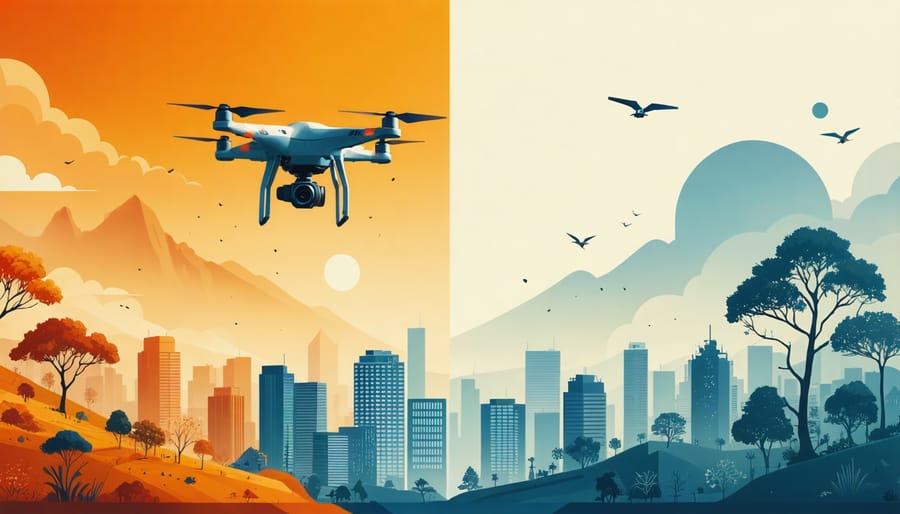
The ethical operation of unmanned aerial vehicles extends far beyond simple regulatory compliance, touching core principles of privacy, safety, and social responsibility. As drone technology revolutionizes photography and data collection, ethical considerations in photography have become increasingly complex. Drone operators must navigate a delicate balance between creative freedom and respect for individual privacy rights, while ensuring their aerial activities don’t disturb wildlife or compromise public safety.
Modern UAV capabilities – from high-resolution cameras to extended flight times – bring unprecedented opportunities for aerial photography and data collection. However, these same capabilities raise serious questions about surveillance, consent, and the responsible use of airspace. Professional operators and hobbyists alike must consider not just what they can do with their drones, but what they should do.
The growing integration of drones into everyday life demands a robust ethical framework that addresses both current challenges and emerging concerns. From residential privacy to environmental impact, the decisions made by UAV operators today will shape public perception and future regulations of this transformative technology.
Legal Framework for Drone Photography
FAA Regulations and Licensing Requirements
Before operating a drone for photography, it’s essential to understand and comply with FAA regulations. In the United States, all drones weighing more than 0.55 pounds must be registered with the FAA, and operators need to obtain proper certification based on their intended use.
For recreational photographers, passing The Recreational UAS Safety Test (TRUST) is mandatory. Professional drone photographers must obtain a Remote Pilot Certificate (Part 107 license), which requires passing a knowledge test covering airspace regulations, weather patterns, and operational procedures.
Key flight restrictions include maintaining visual line of sight, flying below 400 feet, avoiding restricted airspace, and not flying over people or moving vehicles. Night operations require additional authorization and proper lighting equipment. Special waivers may be needed for certain types of shoots, particularly in controlled airspace or densely populated areas.
Weather conditions also play a crucial role in legal compliance. Operators must maintain visibility of at least 3 miles and stay 500 feet below clouds. Remember that local regulations may impose additional restrictions beyond FAA requirements, so always check area-specific rules before flying.
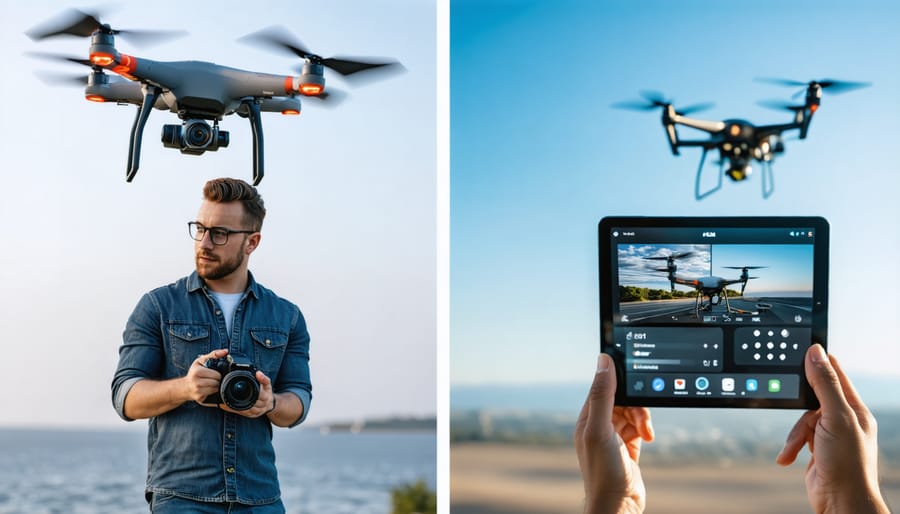
Local and State Privacy Laws
Privacy regulations for drone operations vary significantly across different states and local jurisdictions, making it essential for drone photographers to research and understand the specific laws in their area. For instance, California has stricter privacy laws that prohibit using drones to capture images of private property without consent, while other states may have more lenient regulations.
Many local municipalities have enacted their own drone ordinances that go beyond federal regulations. These might include restrictions on flying over residential areas, specific height limitations, or requirements for additional permits. Some cities have designated “no-drone zones” around sensitive areas like schools, hospitals, or government buildings.
It’s worth noting that privacy laws are constantly evolving as drone technology becomes more prevalent. What’s legal in one county might be restricted in another, even within the same state. Smart drone operators maintain a database of local regulations and regularly check for updates, particularly when traveling to new locations for shoots.
Before any flight, photographers should verify both state and local privacy requirements, obtain necessary permits, and document their compliance efforts. This proactive approach helps avoid legal issues while maintaining positive relationships with local communities.
Privacy Considerations in Aerial Photography
Residential Privacy Rights
Operating a drone near residential areas requires careful consideration of privacy rights and respect for personal space. As a drone photographer, it’s essential to understand that people have a reasonable expectation of privacy in their homes and private spaces, even if these areas are visible from above.
Always maintain a respectful distance from residential properties, particularly when cameras are recording or photographing. A good rule of thumb is to stay at least 50 feet away from private residences horizontally and avoid hovering directly over properties without explicit permission. Pay special attention to spaces like backyards, swimming pools, and areas where people might reasonably expect privacy.
Before conducting any drone photography in residential areas, consider:
– Informing nearby residents about your planned flight
– Obtaining written permission when photographing specific properties
– Avoiding flight paths that might capture private activities
– Being mindful of windows and outdoor living spaces
– Respecting “No Drone Zone” signs and property owner requests
Remember that while aerial views might provide stunning compositional opportunities, they should never come at the cost of someone’s privacy. If you’re unsure whether your shooting location might infringe on privacy rights, err on the side of caution or seek legal counsel.
When sharing or publishing residential drone footage, always ensure you have necessary releases and avoid including identifiable details of private properties without consent.
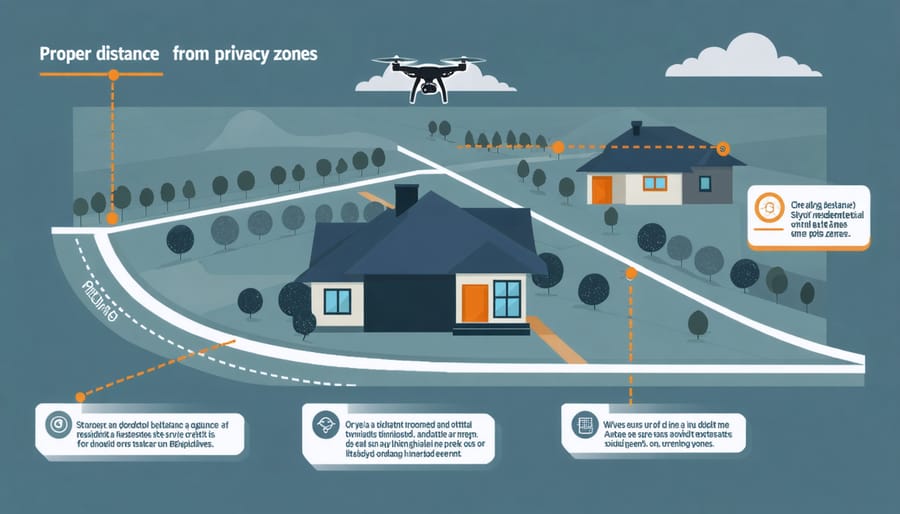
Public Space Photography Ethics
When operating a UAV for photography in public spaces, photographers must navigate a complex balance between creative expression and ethical responsibility. Understanding privacy rights in public spaces is crucial, as drone photography introduces unique challenges that traditional street photography doesn’t face.
First, always consider the reasonable expectation of privacy, even in public areas. While people in public spaces may expect to be photographed from street level, aerial photography can capture private moments in traditionally protected spaces like backyards or roof terraces. Exercise discretion and avoid photographing areas where people have a legitimate expectation of privacy.
Be mindful of crowd photography from above. While it’s generally legal to photograph groups in public places, hovering a drone over crowds can cause discomfort and anxiety. Maintain a respectful distance and avoid prolonged focusing on individuals without their consent.
Cultural and religious sensitivities also deserve special consideration. Some locations, such as places of worship or cultural ceremonies, may have specific customs regarding photography. Research and respect these boundaries, even when operating in public airspace.
Consider the impact of your presence. A drone hovering overhead can disrupt public enjoyment of spaces like parks or beaches. Time your shoots during quieter periods and keep flight duration minimal in heavily trafficked areas. Remember, ethical drone photography isn’t just about what’s legally permissible – it’s about being a responsible member of the photography community.
Environmental Impact and Wildlife Protection
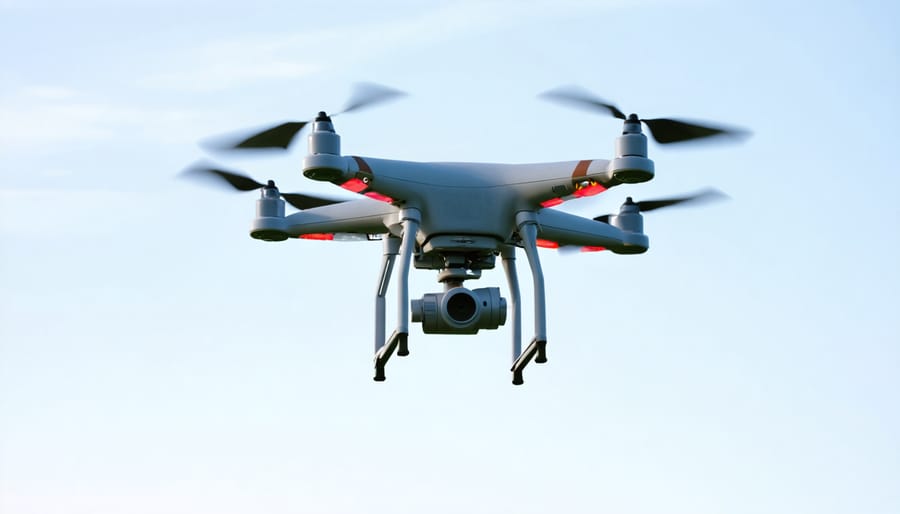
Wildlife Disturbance Prevention
When operating drones near wildlife, it’s crucial to follow established wildlife photography ethics to minimize disturbance to animals in their natural habitat. Always maintain a safe distance of at least 100 meters from any wildlife, and never chase, follow, or harass animals with your drone. Birds are particularly sensitive to aerial disturbances, so avoid flying during nesting seasons or in known breeding areas.
Consider using zoom lenses rather than getting physically closer with your drone, and watch for signs of distress such as animals fleeing or displaying defensive behaviors. If you notice any such reactions, immediately increase your distance or land your drone. Dawn and dusk are especially sensitive times for many species, so limit flights during these periods.
Before launching your drone in natural areas, research local wildlife patterns and protected species. Some locations may have specific seasonal restrictions or complete drone bans to protect vulnerable populations. Remember, getting the perfect shot should never come at the expense of an animal’s wellbeing or natural behavior.
Protected Areas and Sensitive Locations
When operating drones in or near protected areas, photographers must exercise exceptional care and responsibility. National parks, wildlife refuges, and other sensitive environments often have strict regulations regarding accessing protected areas with UAVs. Before launching your drone, always check local guidelines and obtain necessary permits.
Wildlife is particularly vulnerable to drone disturbance. Maintain significant distance from nesting sites, breeding grounds, and animal habitats. Even seemingly minor disruptions can cause stress to animals and affect their natural behaviors. During migration seasons, be especially mindful of bird populations and their flight paths.
Historical sites and cultural landmarks also require special consideration. Many of these locations prohibit drone flights to preserve their integrity and visitors’ experience. When permitted, maintain respectful distances and avoid flying directly over archaeological sites or sacred spaces.
Consider the time of day and season when planning your flights. Early morning or late evening flights might disturb wildlife during their most active periods. Always prioritize environmental preservation over getting the perfect shot, and document these sensitive locations from approved vantage points only.
Best Practices for Ethical Drone Photography
Pre-Flight Planning and Permission
Before taking your drone to the skies, thorough pre-flight planning is essential for both legal compliance and ethical operation. Start by checking local regulations and airspace restrictions through official aviation authority websites or apps. Many countries require drone registration and pilot certification, so ensure your paperwork is current and readily available.
Research your intended flight location carefully. Are you near airports, helipads, or restricted areas? Is it a residential zone where privacy concerns might arise? Use reliable airspace maps to identify no-fly zones and height restrictions. Weather conditions are equally crucial – check wind speeds, precipitation forecasts, and visibility reports for your planned flight time.
Always secure necessary permissions from property owners or local authorities when flying over private or public spaces. If you’re planning to capture images of events or populated areas, consider obtaining written consent from organizers or relevant stakeholders. This is particularly important for commercial shoots.
Create a pre-flight checklist that includes equipment inspection, battery levels, and emergency procedures. Document your flight plan, including takeoff and landing zones, maximum altitude, and flight duration. Consider potential obstacles like trees, power lines, or buildings that could interfere with your flight path.
Remember that responsible planning not only keeps you compliant with regulations but also demonstrates respect for others and helps maintain public trust in drone photography as a legitimate pursuit.
Communication and Transparency
Clear communication and transparency are fundamental pillars of ethical drone photography. Before any flight, take the time to inform nearby residents, property owners, or event organizers about your planned drone operations. A simple conversation can prevent misunderstandings and build trust within the community.
Consider creating informational cards or flyers that explain your purpose, credentials, and contact information. These materials can help ease concerns and demonstrate professionalism when approached by curious or concerned individuals during your shoot.
When photographing in public spaces, be visible and identifiable as the drone operator. Wear appropriate identification or branded clothing when possible, and always keep your drone registration and pilot credentials readily available. This transparency helps legitimize your presence and makes others feel more comfortable with your activities.
Social media and personal websites are excellent platforms for sharing your drone photography ethics policy. Document your commitment to privacy, safety, and environmental responsibility. When posting drone photographs, consider including information about the permissions obtained and safety measures taken.
Maintain open channels of communication with local authorities, photography communities, and environmental groups. Their feedback can help you refine your practices and stay informed about community concerns. Remember, being proactive in your communication efforts not only promotes good relations but also helps advance the reputation of drone photography as a responsible and professional pursuit.
Data Protection and Image Rights
When operating a UAV for photography, responsible data management and protection of image rights become crucial ethical considerations. Every aerial photograph you capture may contain sensitive information or include individuals who haven’t consented to being photographed, making it essential to handle this data with care and respect.
Start by implementing a robust data management system for your drone footage. Store your images securely, preferably using encrypted storage solutions and regular backups. When sharing or publishing drone photographs, be mindful of any identifiable individuals, private properties, or sensitive locations that may be visible in your shots.
Consider obtaining proper releases and permissions when photographing private properties or events. While public spaces generally allow photography, certain locations may have specific restrictions or require special permits for commercial drone photography. Always check local regulations and obtain necessary clearances before flying.
Be particularly cautious when capturing images of residential areas. Avoid storing or sharing photographs that might reveal security vulnerabilities of properties or compromise someone’s privacy. If you accidentally capture sensitive information, delete it immediately and ensure it’s not recoverable.
For commercial drone photographers, maintaining clear records of image rights and usage permissions is essential. Create detailed contracts specifying how images will be used, stored, and shared. This protects both the photographer and the subjects while maintaining professional integrity in drone photography.
As we’ve explored throughout this article, drone photography presents both incredible creative opportunities and significant ethical responsibilities. The key to responsible drone operation lies in striking a balance between artistic expression and respect for privacy, safety, and environmental concerns.
Remember that every time you launch your drone, you’re not just a photographer – you’re an ambassador for the entire UAV community. By following legal guidelines, respecting privacy boundaries, and considering environmental impact, you help ensure the future of drone photography remains bright and accessible to all.
Moving forward, commit to these essential practices: always research local regulations before flying, maintain a safe distance from people and wildlife, seek permission when photographing private property, and be mindful of noise pollution and environmental disruption. Consider joining local drone photography groups or professional organizations to stay informed about best practices and contribute to positive community relations.
The future of drone photography depends on each operator’s commitment to ethical conduct. By making responsible choices today, we help preserve creative freedoms for tomorrow’s aerial photographers. Let’s work together to demonstrate that drone photography can coexist harmoniously with privacy rights, environmental conservation, and public safety.
Take the first step today by reviewing your current practices and identifying areas for improvement. The sky’s the limit – but only if we fly responsibly.
